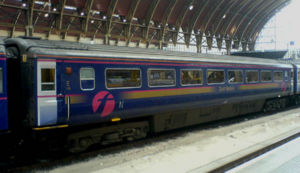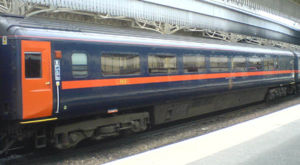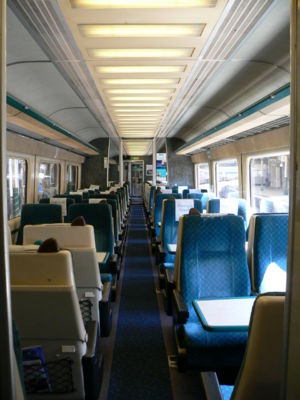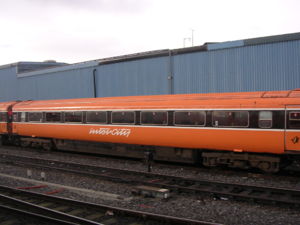British Rail Mark 3
British Rail's third design of carriage was designated Mark 3, and was introduced in 1976 primarily for use on the High Speed Train (HST). The coaches were also intended to be used as conventional loco-hauled stock as part of the West Coast Main Line (WCML) northern electrification sceheme in the mid-'70's; these derivative versions being known as "Mark 3A" and "Mark 3B". The loco-hauled versions have detail differences in their design, and are therefore not interchangeable with Mark 3s intended for use as part of HST formations. The final batch was built in 1988, however Mark 3-based multiple units continued to be built until the early 1990s.
Construction
At first glance, the Mark 3 looks similar to the later versions (2D/2E/2F) of the Mark 2 coach, but is in fact a completely different design.
The bodyshell is three metres longer than the Mark 2, of full monocoque construction and has gained a strong reputation within the railway industry for its exceptional strength and crashworthiness.
Another important advance over its predecessor was the adoption of air suspension on the wheel bogies. The bogies themselves were improved in order to accommodate sustained running at over 110mph, with a 125mph maximum speed - the Mark 2 is nominally limited to 100mph.
Ancillaries such as electrical and air conditioning systems were grouped together in discrete modules housed behind an aerodynamic skirting between the wheel bogies - on the Mark 2 these were randomly mounted above and below the passenger seating area. The lighting and air conditioning fittings were for the first time integrated into the ceiling panels.
Other new features (first seen on the Mark 2F) were the automatic gangway doors which were triggered by pressure pads under the floor, and a speed operated central door locking system for the manually operated slam-doors.
| Mark | Built | Features |
|---|---|---|
| Mark 3 | 1972-85 | The basic model, for use in High Speed Train sets |
| Mark 3A | 1975-84 | The basic model, for use in locomotive-hauled rakes |
| Mark 3B | 1985-88 | Improvement of the Mark 3A with new styles of seating and lighting |
Usage
The Mark 3 design proved to be highly adaptable for use in BR's multiple unit stock of the 1980s - AC EMU Classes Class 317 - 322, the DC Class 455 and DMU Classes 150 & 156 all use a Mark 3 derived bodyshell.
Since 1977, the Royal Train has used nine specially equipped Mark 3 coaches to transport the British Monarch and other members of the Royal Family. These were built from the original HST prototype vehicles.
Grand Central, a new open access operator on the ECML, will use HST sets on its newly inaugurated services between London and Sunderland [1]. The Mark 3 coaches to be used are of the loco-hauled type, and so are undergoing modifications to their couplers and electrical systems to make them compatible with Class 43 power cars. They have a limited role on the WCML, with the overnight Caledonian Sleeper services between Scotland and London Euston still using Mark 3 sleeper coaches.
Following the introduction of Virgin Trains' new fleet of Pendolino electric multiple units onto the WCML, a huge surplus of Mark 3 vehicles now exists across the network. Some of the former Virgin coaches have been refurbished and cascaded onto the Great Eastern Main Line, replacing the Mark 2E/2F vehicles which have operated London-Norwich services. They also continue to be used by First Great Western on the Great Western Main Line, and GNER on the East Coast Main Line franchise. Ex-Virgin Mark 3's have also made a brief return to the WCML in the summer of 2006, with a small number of coaches covering peak time Euston - Birmingham New Street services whilst the Pendolinos undergo modifcations.
In January 2007, the first of GNER's refurbished Mark 3 coaches was unveiled - these have been internally refitted to the same standard as its "Mallard" Mark 4 stock with the same styles of seating and lighting. The new Mark 3 Mallard sets have been converted by Wabtec in Doncaster, and will be steadily rolled out over the next two years.
The Mark 3 in Ireland
Ireland's national rail operator, Iarnród Éireann, has a fleet of these Mark 3 carriages with 1600 mm (5 ft 3 in) gauge bogies. The fleet is 123 Mark 3s and 9 Mark3As. As of 2004 they form the main body of the intercity rolling stock on the Irish railway network. They were built in 1980, 1986 and 1989. They are air-conditioned with automatic doors - the doors caused some concern at the time as additional time and resources were required to perfect them. Some currently run in push-pull configuration and some have windows that open. A number of coaches are first class, and there are several dining carriages and some driving van trailers (DVTs include passenger seating). An accompanying generator van supplies power. Iarnród Éireann intend to replace these carriages within the next few years with new carriages built by CAF of Spain, and "regional railcars" (DMUs).
References
- British Rail 1948-78: A Journey Through Design, Brian Haresnape (1979).
See also
External links
| Wikimedia Commons has media related to: British Rail Mk3 coaches |
| Coaching stock of British Rail Mark 1 - Mark 2 - Mark 3 - Mark 4 | |||
|---|---|---|---|
| Passenger coaches | |||
| Mark 1: | BCK - BFK - BSK - BSO - BSOT - CK - FK - FO - RB - RBR - RF - RKB - RMB RU - SK - SLC - SLF - SLSTP - SO - TSO |
||
| Mark 2: | BFK - BSK - BSO - BSOT - BUO - DBSO - FK - FO - FOT - PFB - PFK - PFP RFB - RLO - RMBF - RSS - SK - SO - TSO - TSOT | ||
| Mark 3: | BFO - CO - FO - RFM - SLE - SLEP - TSO - TSOB (Locomotive-hauled) TF - TGS - TRB - TRFB - TRFK - TRSB - TS (HST trailers) | ||
| Mark 4: | FO - RBF - RSB - TSO - TSOE | ||
| Non-passenger coaches | |||
| Mark 1 | BG - BPOT - BV - Courier - GUV - PCV - POS - POT | ||
| Mark 3 & 4: | DVT | edit | |





